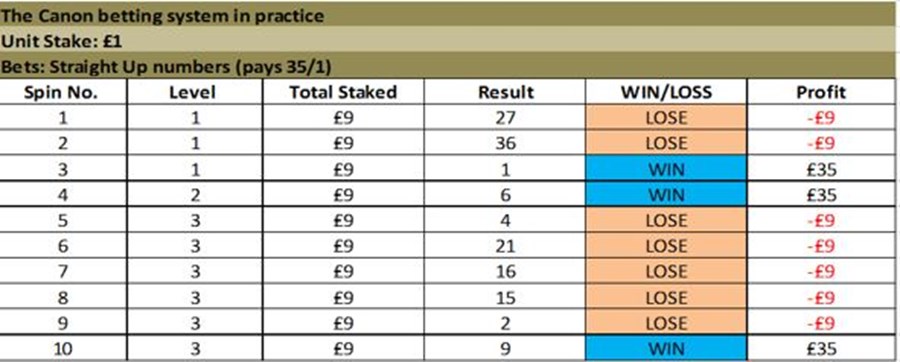Roulette strategy 101: What is the Cannon betting plan?

The Canon System is a basic roulette staking plan that can improve your bankroll management. Let's explore the basics of this simple betting system.
Some online roulette systems require complex number patterns or adjustments to stakes.
The Canon System works a little differently: the player sticks to a set amount and ends their session when they reach a 70-unit profit. It's that simple.
Of course, roulette players can experience downswings, and the Canon System caters for the losing gamblers, too. Let's take a closer look at this flat staking system for roulette games.
How the Canon roulette system works
If you like simple roulette staking plans, you'll like the Canon System. There are a few simple but strict rules to follow. Stick to the rules, never deviate, and you could come out a winner.
The main thing to remember is that there is a win target in the Canon System. This is +70 units.
There is also a loss limit of -100 units. Once either of those targets is met, the betting session ends and the player begins again.
Using the Canon plan at the casino
In many roulette plans, players bet on the outside areas like Red/Black and Odd/Even. These pay 1/1 and carry the lowest payouts on the table. They are, however, easier to hit, as you are covering more possible numbers.
The Canon System is a little more action-packed. Players cover a set of nine 'straight up' numbers on each spin. One chip of 1 unit stake is placed on each number. Each number pays 35/1.
Bets are made on the same set of nine numbers until you hit a winner. You then move onto the next set and follow the same procedure.
Players can hit five straight losing spins before moving onto the next level. If you hit Level 12 and haven't reached our win or loss target, you move back to Level 1 and begin all over again.
Levels in the Canon System
Let's assume we are playing European Roulette, with a single zero spot. Here are the sets of numbers to bet on:
Level 1: 1, 2, 3, 20, 21, 25, 26, 33, 35
Level 2: 4, 5, 6, 10, 19, 21, 24, 27, 34
Level 3: 7, 8, 9, 22, 23, 28, 29, 30, 31
Level 4: 5, 10, 11, 12, 23, 28, 30, 35, 36
Level 5: 13, 14, 15, 19, 20, 27, 31, 32, 36
Level 6: 16, 17, 18, 22, 24, 25, 29, 33, 34
Level 7: 0, 1, 2, 4, 14, 15, 19, 20, 21
Level 8: 5, 8, 9, 10, 16, 18, 22, 23, 24
Level 9: 0, 2, 3, 6, 13, 17, 25, 26, 27
Level 10: 0, 7, 8, 11, 12, 18, 28, 29, 30
Level 11: 0, 1, 9, 14, 16, 26, 31, 32, 33
Level 12: 3, 6, 11, 12, 13, 17, 34, 35, 36
In our table, our first set of bets is on 1, 2, 3, 20, 21, 25, 26, 33 and 35. We lose two spins, then we hit a winner on 3.
We now move up to Level 2. We win again, so we move up to Level 3.
Now we go on a five-spin losing streak. After the fifth spin of our downswing, we move up a level and continue on.
After 10 spins, we have won three and lost seven. Our total profit is £42. We can now carry on until we reach +70 units and stop the session.

Advantages and disadvantages of the Canon plan
The biggest advantage of the Canon System is that it makes use of the more profitable 'straight up' numbers. These pay 35/1 and offer the best odds in online roulette.
And with strict stop-win and stop-loss limits, the Canon helps players keep a better eye on their bankroll management.
Some versions of the Canon System require the player to increase their unit stake following losing sessions. If you lose more than one session in three, you increase your unit stake to £2.
If you lose further sessions, increase the stake to £3, and so on.
This strategy has its dangers, of course. There is every possibility you can go on a long-term downswing and end up chasing some massive losses.
One further disadvantage of roulette is that the house edge is always against the player. In European Roulette, the edge is 2.7%, meaning that, over the long-term, the casino will win £2.70 for every £100 wagered.
Test out the Canon system today
Give the Canon System a try with different roulette variations and see how your bankroll does.
The Canon isn't a fool-proof plan, and with only nine numbers covered on every spin, long downswings are possible.
But if you don't like even-money negative progression systems, the Canon plan offers something a little more unique.




































